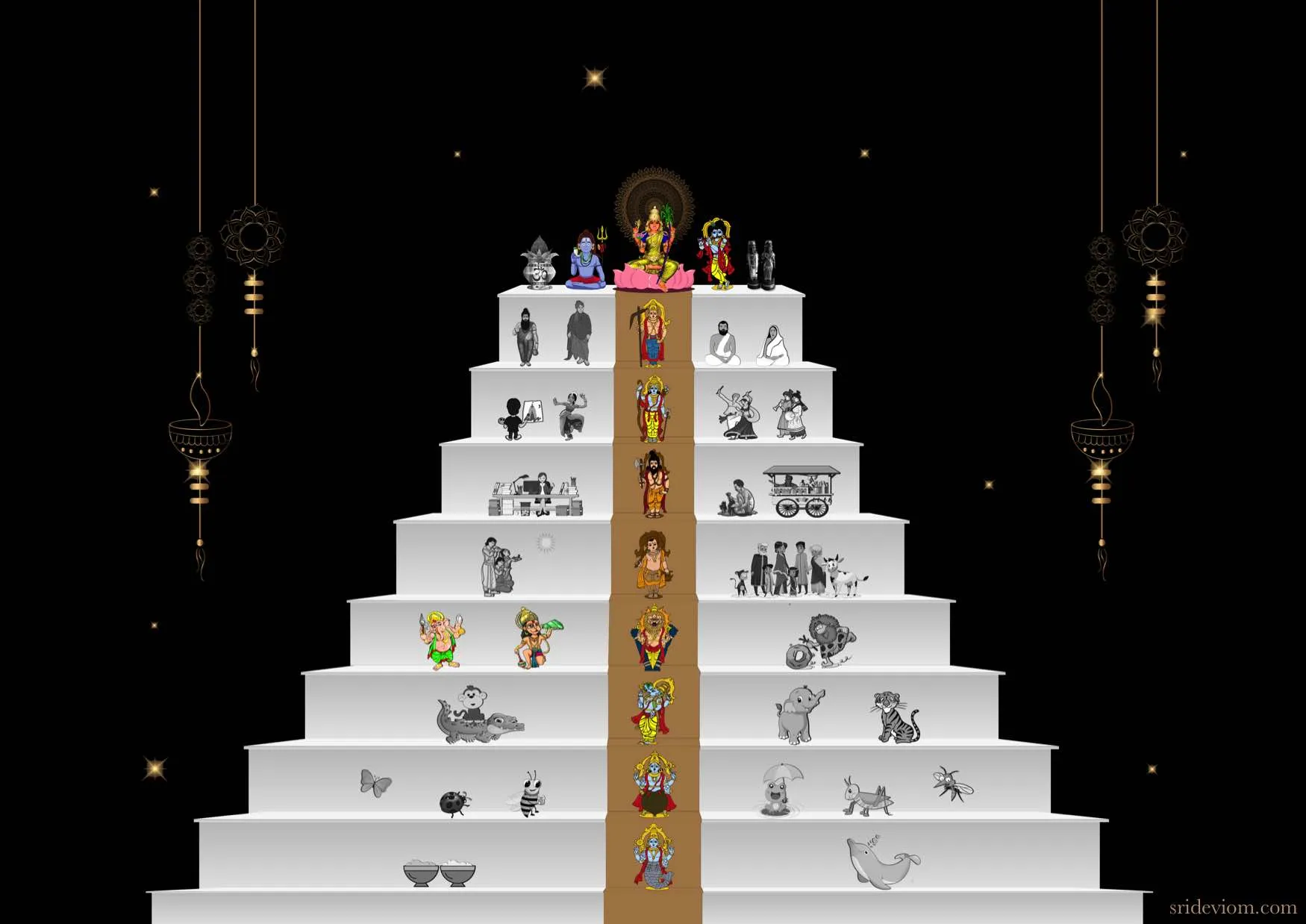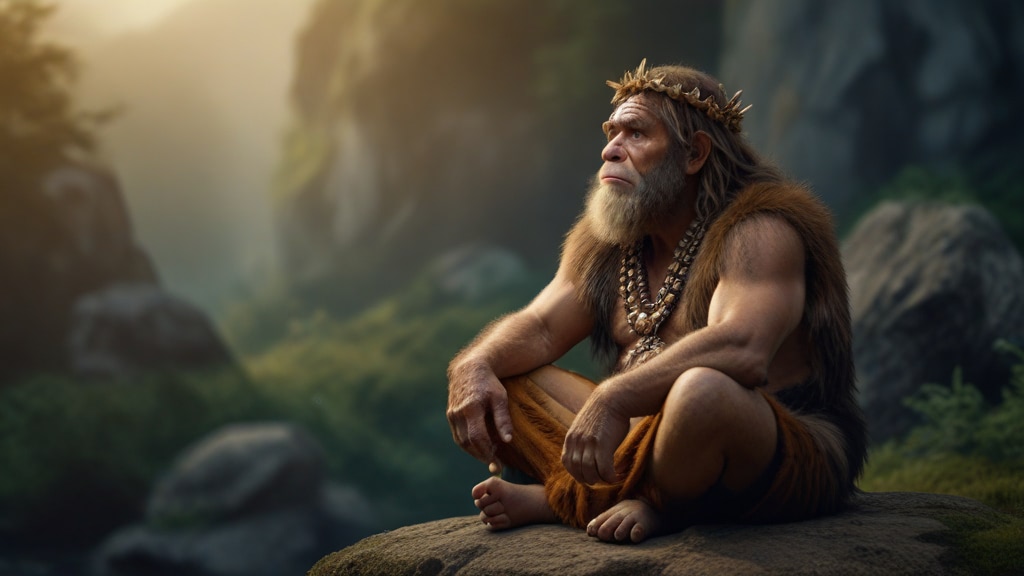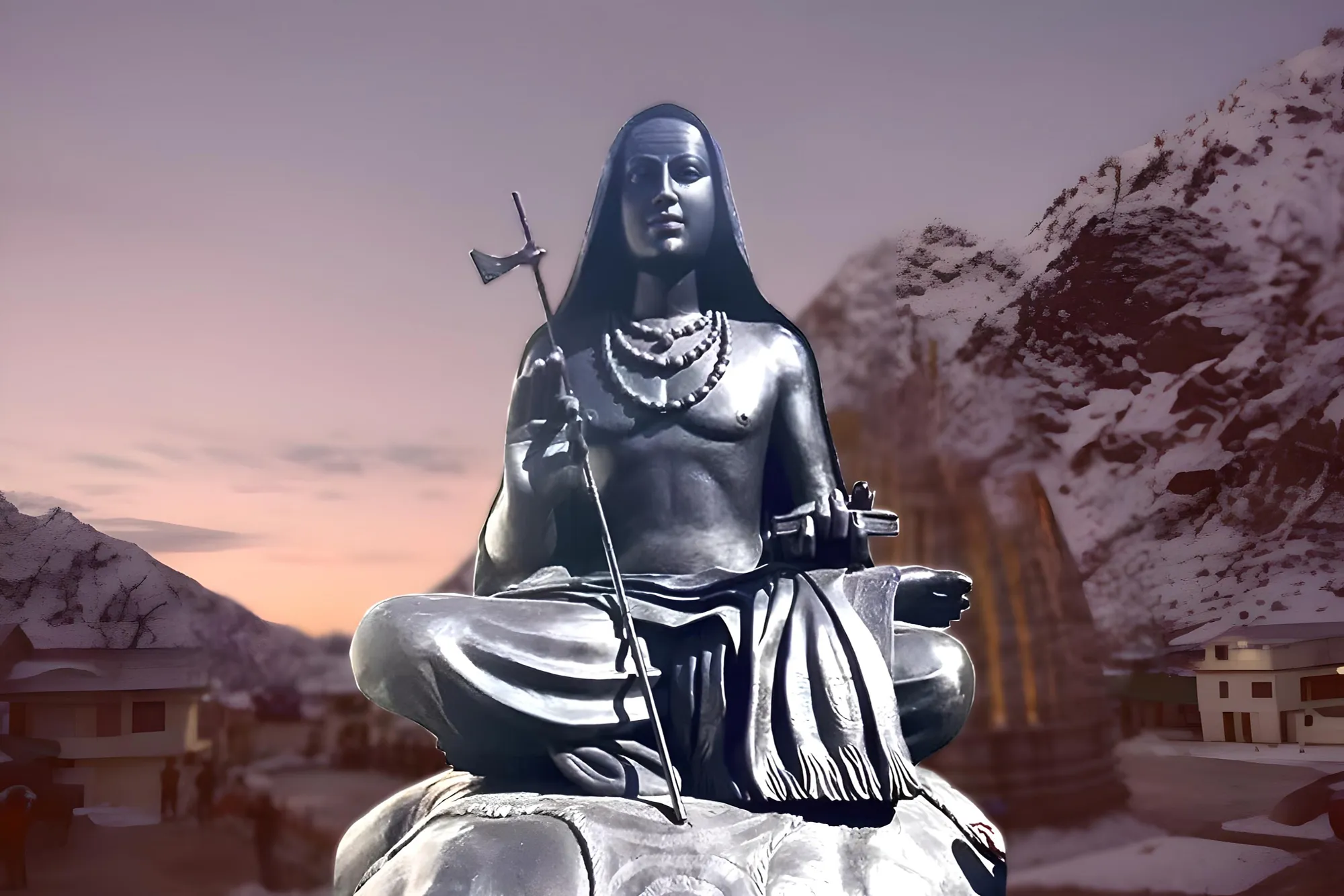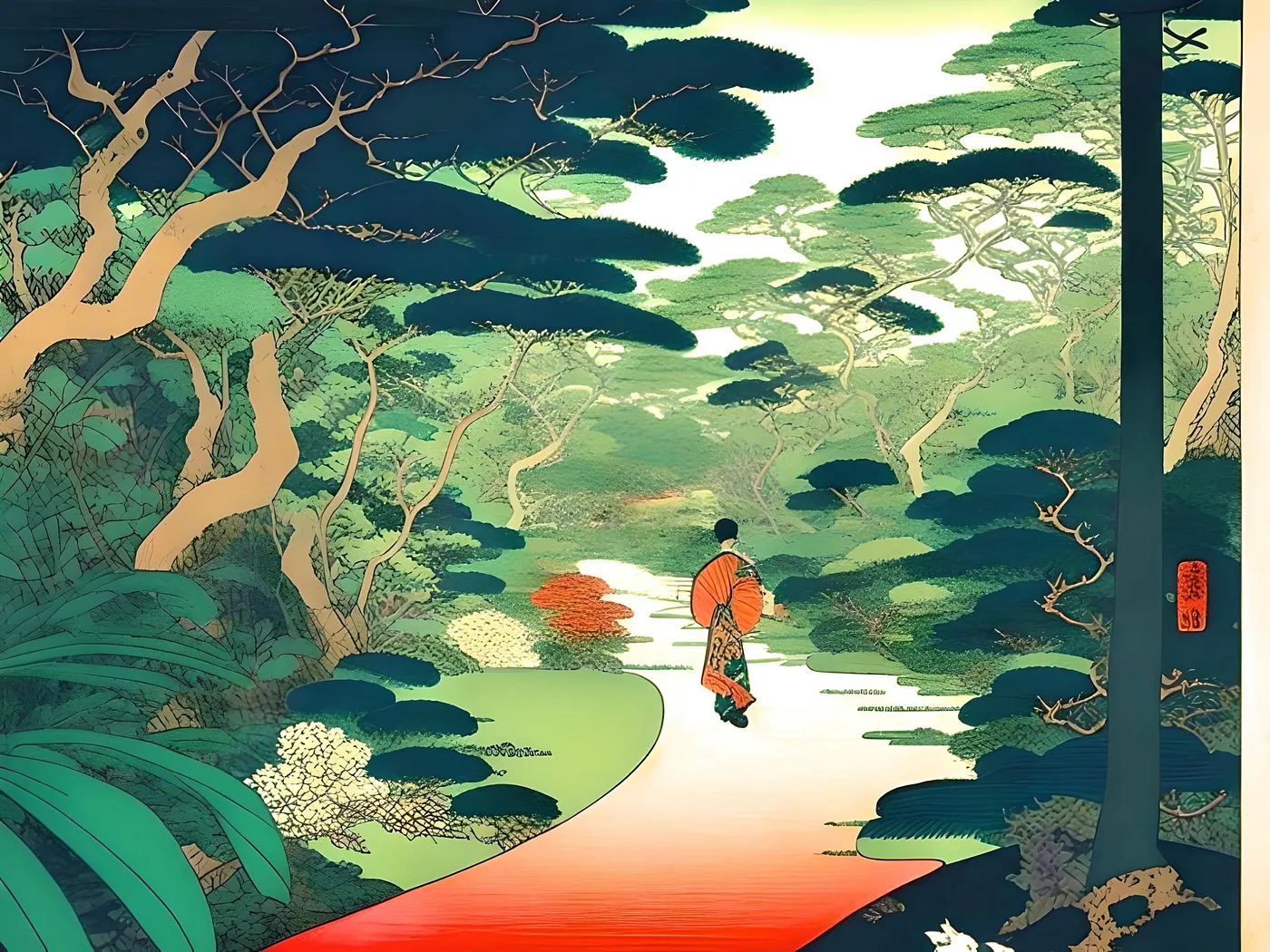Golu (गोलु) or Kolu, the showcase of figurines, is a popular tradition in Southern India. It’s part of the Sharad Navaratri, the fall (autumn) Devi fest.
Golu means rounded, a derivative of the Sanskrit Gola, which means sphere or globe. In Tamil, an ancient language still spoken widely, Kolu means Royal or Divine Presence.
As the names suggest, the Golu tradition tries to teach kids spirituality through Earth Science and Human Evolution.
Sri Devi, Shiva and Vishnu
The Golu tradition comes from the Shakta sub-tradition of Sanatana Dharma. The main Divine here is Sri Devi, which means Divine Energy. The wisdom and path to Her is called Sri Vidya.
Sri Lalita Sahasranamam, an integral part of Sri Vidya, eulogizes Her as Karanguli Nakhotpanna Narayana Dashakritihi — from Her nails emerged the ten avatars of Hari (Vishnu).
The same chant also says Shiva Shakti Ikya Rupini — She is a merged form of Shiva and Shakti.
In other words, Sri Devi is the same as Vishnu and Shiva. These are all different names for the same Divine Energy.
Taking this thought forward, Vishnu’s Dasavatar is the central theme of a Golu. Also, a traditional Golu always has nine steps of statuettes to honor Sri Devi, nine being a number associated with Her.
Significance of Vishnu’s Ten Main Avatars
Dasavatar, Vishnu’s ten primary forms, depicts evolution. Not just physically but emotionally and spiritually as well.
Below is their symbolism, along with the Golu placement (please embrace yourself for a long post because I wanted to write about all the avatars at once):
1. Matsya, The Fish
- Evolution: Lord Vishnu was initially a marine being — a fish. According to modern evolution theories, life started on marshy grounds, but the first major explosion of life forms was primarily aquatic.
- Golu First Step (from bottom): This step contains aquatic beings, denoting the Matsya Avatar. It also displays inanimate things and life forms at the lowest end of the food chain to indicate everything is Divine.
2. Kurma, The Turtle
- Evolution: Gradually, life forms moved out of water. Vishnu’s second form was an amphibian: the turtle or Kurma to signify this movement.
- Golu Second Step: Correlating with the Kurma Avatar, this step showcases amphibians, insects, and other crawling and creeping life forms.
3. Varaha, The Wild Boar
- Evolution: As life forms adapted to land, they evolved into four-legged beings. The Varaha, or the wild boar form of Vishnu, represented that.
- Golu Third Step: This step contains all sorts of animals and birds. Panchatantra stories find their place here as well.
4. Narasimha, Part-Human, And Part-Lion
- Evolution: Lord Vishnu’s Narasimha Avatar was half-lion and half-man. This form depicts primordial humans, who might have evolved from other vertebrates. That ideology is in line with Darwin’s theory.
- Golu Fourth Step: Depicting prehistoric humans, figurines of cave dwellers, and other primitive lifestyles go here. The devoted Hanuman and Lord Ganesha belong here as well.
- Esoteric: The legend of Narasimha alludes to the dangers of the human intellect, which can spiral out of control to become manipulative, as demonstrated by Asura Hiranya-Kashipu. Surrendering to the divine, like Prahalad, keeps our intellect in check, making our thoughts pure.
5. Vamana, The Dwarf
- Evolution: The early humans, like the Vamana Avatar, were short in height. Eventually, they also started living in communal groups.
- Golu Fifth Step: The transition of early humans to live in communities is the theme of this level.
- Esoteric: In this avatar’s story, the just Asura King Maha-Bali pursued the divine, but he couldn’t see Vamana’s divinity. Similarly, people remain stuck in the mundane, unaware of the divinity latent in them and all.
6. Parashu-Rama, The Skilled One
- Evolution: With time, homos developed well-formed bodies. Similar to the Parashu-Rama Avatar, they excelled in using tools and weapons.
- Golu Sixth Step: This step portrays human advancements in skilled labor, trade, agriculture, vendors, etc. Today, we can also add malls, corporate professionals, modern advancements, and so on!
- Esoteric: Parashu-Rama’s tale indicates physical robustness, worldly skills, and social service. However, his short temper and brute force lead him to inner turmoil.
7. Rama, The Gracious Human
- Evolution: The next human development is about evolving emotionally. As signified by the Rama Avatar, discipline and emotional maturity are vital to our well-being.
- Golu Seventh Step: The seventh Golu step indicates the trained mind. It showcases writers, musicians, dancers, artisans, painters, and other evolved human activities.
- Esoteric: Striving to be kind-hearted and emotionally mature is the basis of spiritual evolution. By being Purushotam, the superlative human, Lord Rama brought reforms. He demonstrated discipline, the signature of intelligent living.
8. Bala-Rama, Exploring Our Divinity
- Evolution: When we are intellectually pure, physically robust, worldly skilled, and emotionally balanced, we move on to spiritual self-discovery.
- Golu Eighth Step: Statues of divine humans, like exalted saints and monks, decorate the eighth step of the Golu.
- Esoteric: Unlike Lord Rama, supernatural elements were at work in the Bala-Rama Avatar. It indicates the growing power of the mind due to spiritual austerities.
- A Side Note: Bala-Rama, the brother of Krishna, is Lord Vishnu’s eighth incarnation. He was Ananta-Sesha, who is also considered an avatar of Vishnu. Scriptures state that divine beings can simultaneously take many avatars on this planet.
9. Krishna, The Complete Incarnation
- Evolution: When life feels spiritually complete, we sense the Divine in us.
- Golu Ninth Step (topmost): All manifested divine forms belong to this level, but the Supreme Goddess takes the center spot. After all, Navaratri is the Divine Mother’s festival, and Golu is a part of it!
- Esoteric: Krishna was Lord Vishnu’s Poorna Avatar or complete incarnation. He embodies love, compassion, and Divine presence.
- A Side Note: A married couple made of Marapachi or wood occupies the final Golu step — to represent the Vedic philosophy of masculine and feminine principles. Sometimes, a Kalash, the auspicious pot of water invoking Goddess Kamalatmika, is placed here.
10. Kalki, The Formless Divine
- Evolution: Lastly, we’ve reached a stage beyond creation. An avatar or a divine-human has wholly merged into Divine Energy.
- Golu Step: There isn’t any Golu step representing this. Besides, Navaratri is a festival of nine nights, and it makes sense to have nine steps.
- Esoteric: The idea symbolized here is Samadhi — a feeling of a complete merger into the Divine Energy.
- A Side Note: Kalki is scheduled to visit us this Kali Yuga, the current scriptural era. The Harivansha Purana prophesies his birth in a priestly community in Shambala or Siddha-Ashram. Maybe he’s already out there reviving Sanatana Dharma? Why not, right?
Everything in this creation is Divine. We all have taken many births and are headed to the Divine Energy. Ultimately, that’s the Spiritual Truth of every being, which the Golu tradition symbolizes.
Love,
Sri Devi Om



